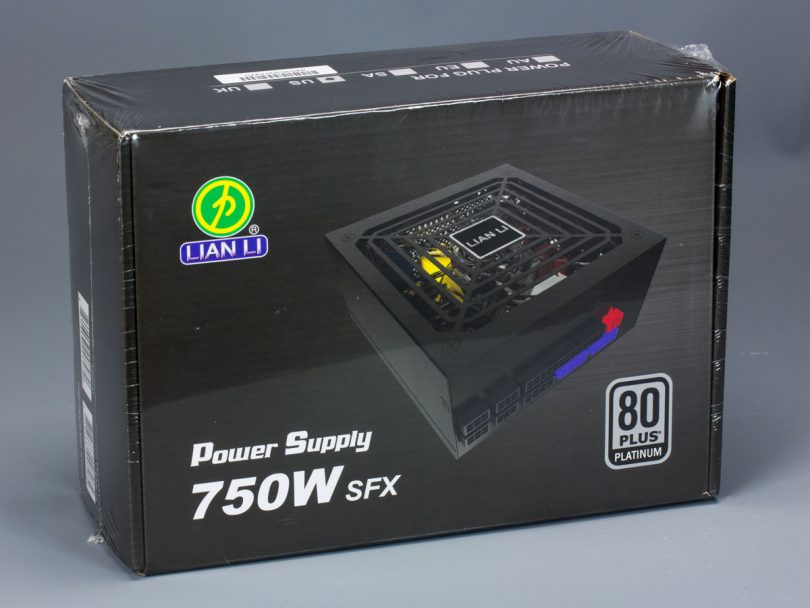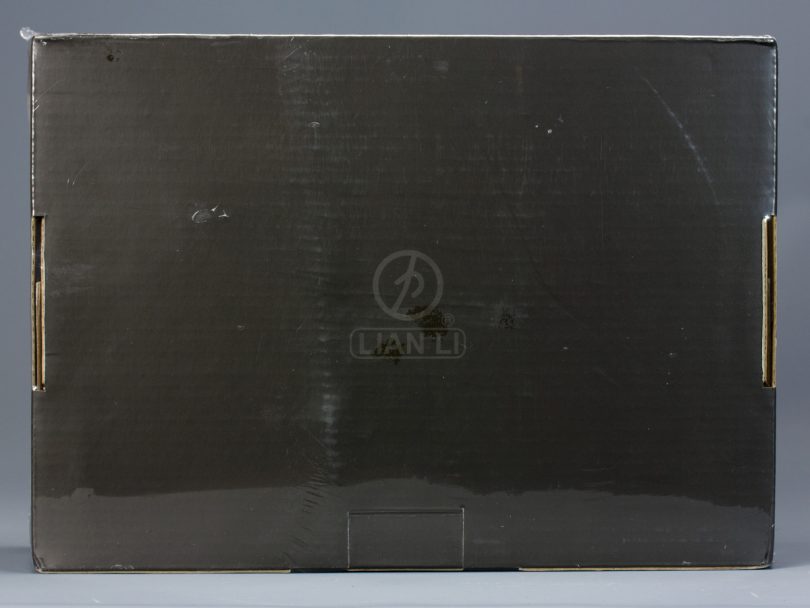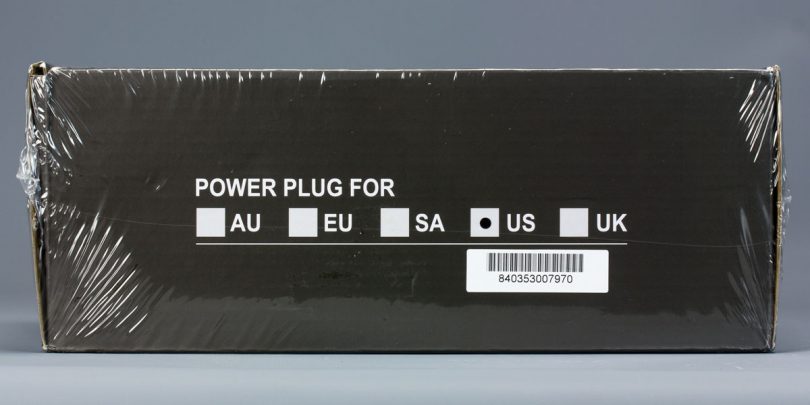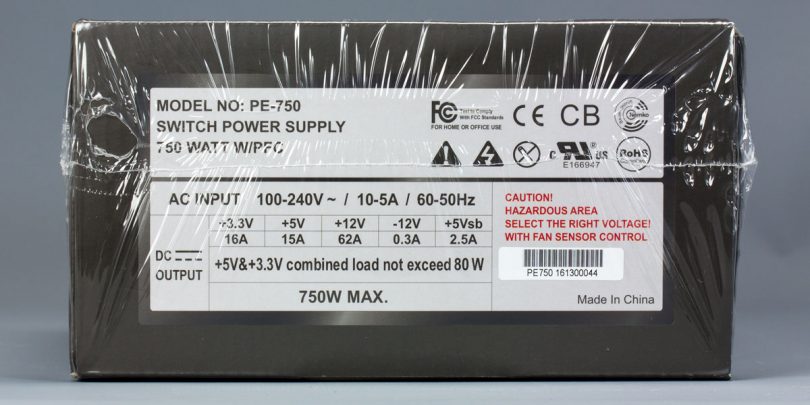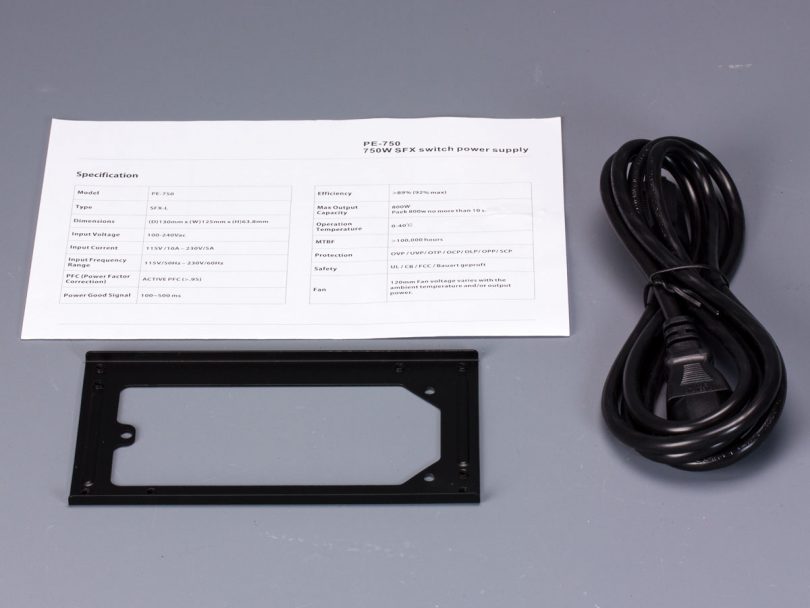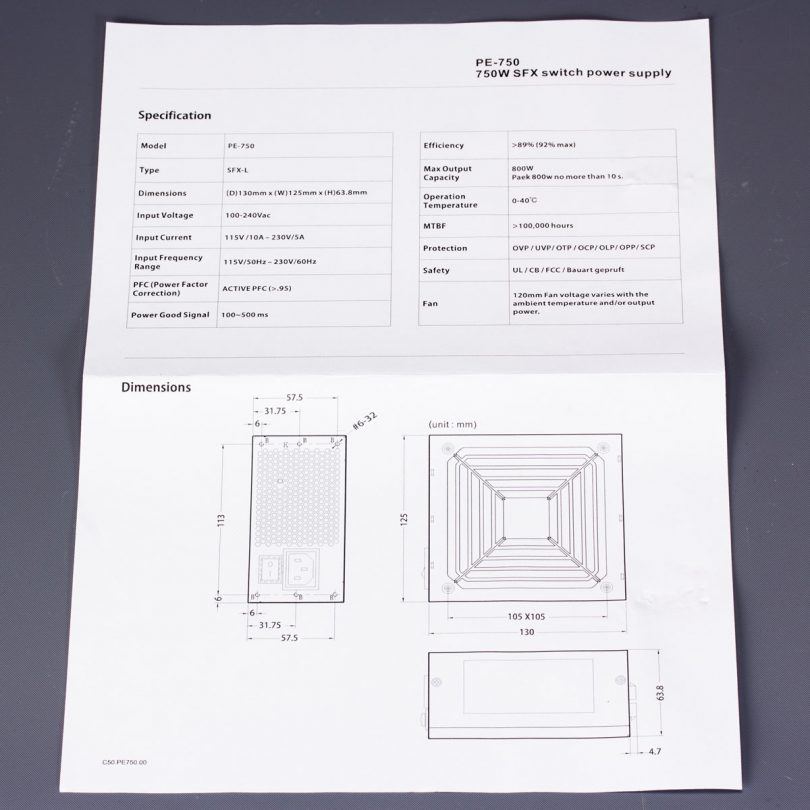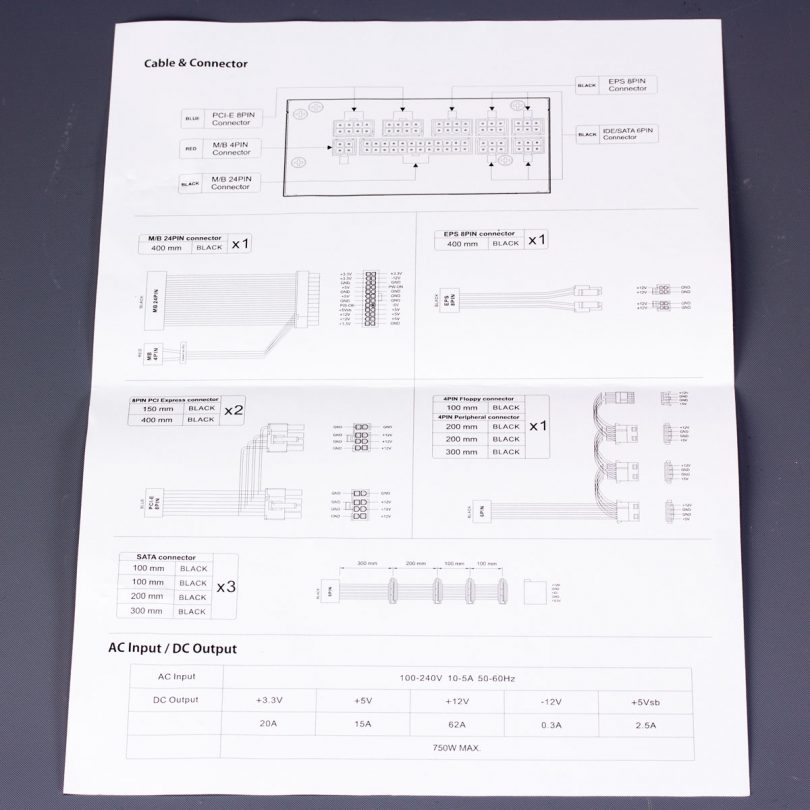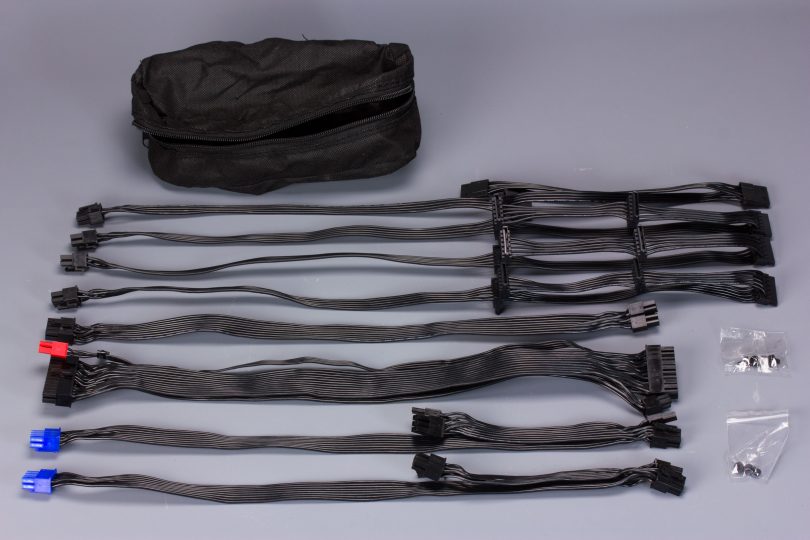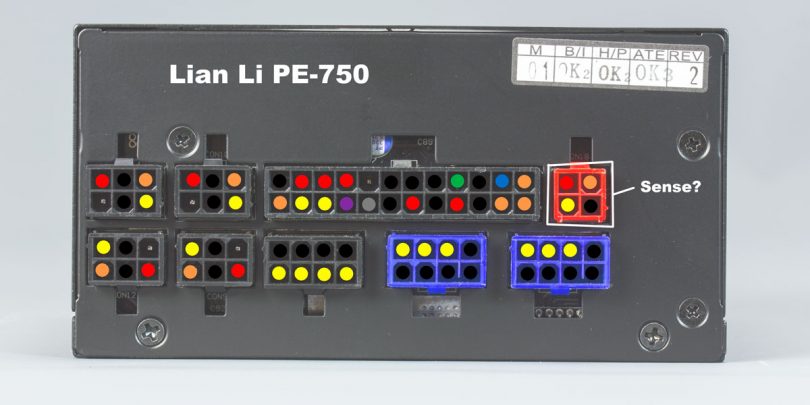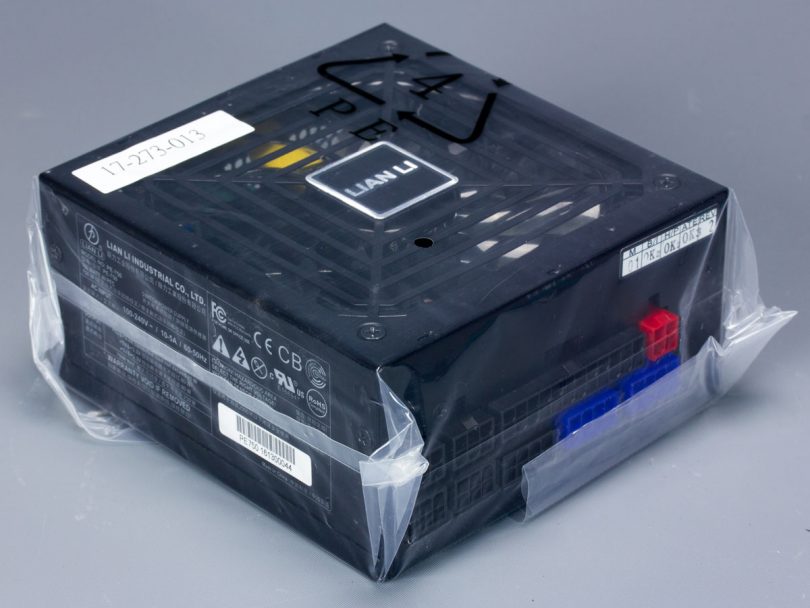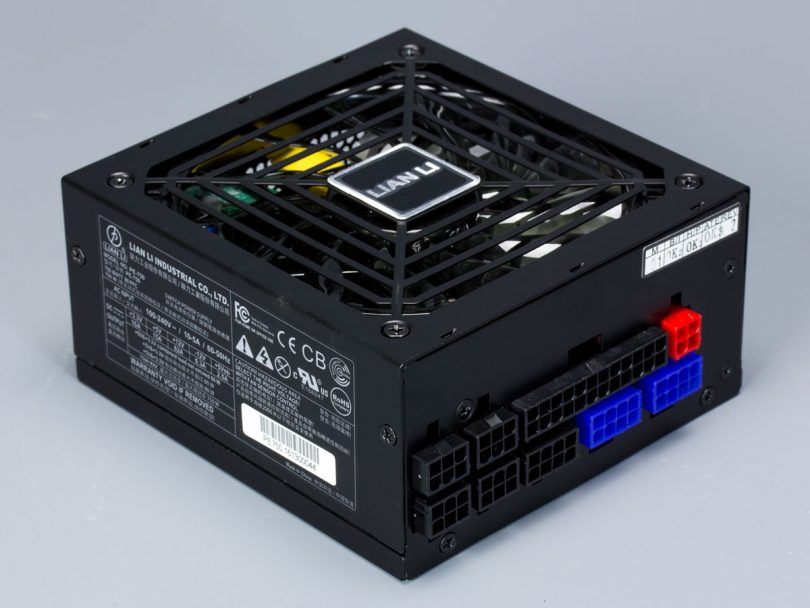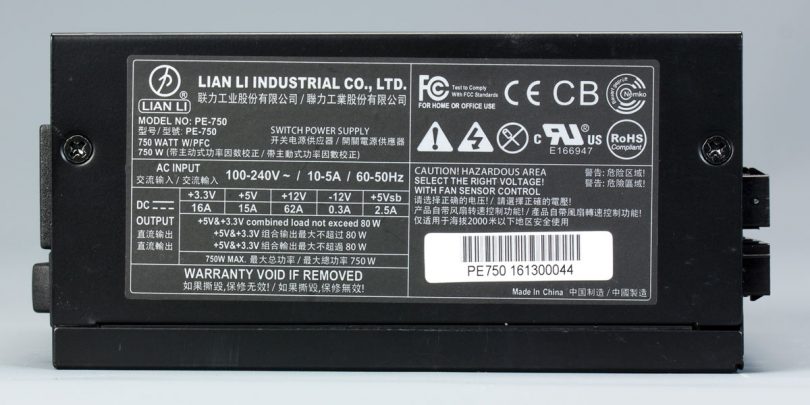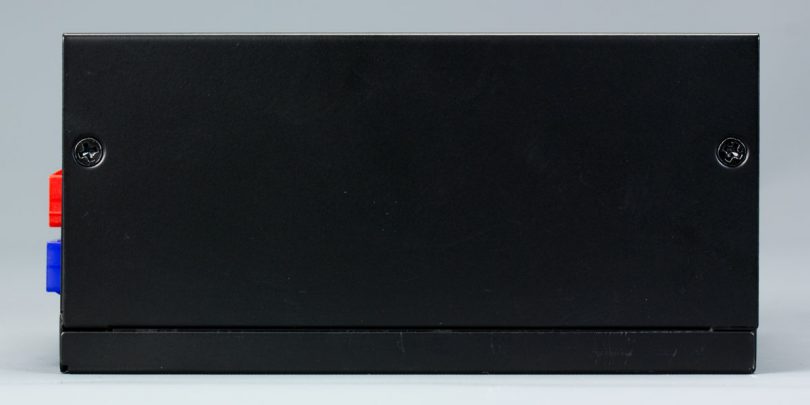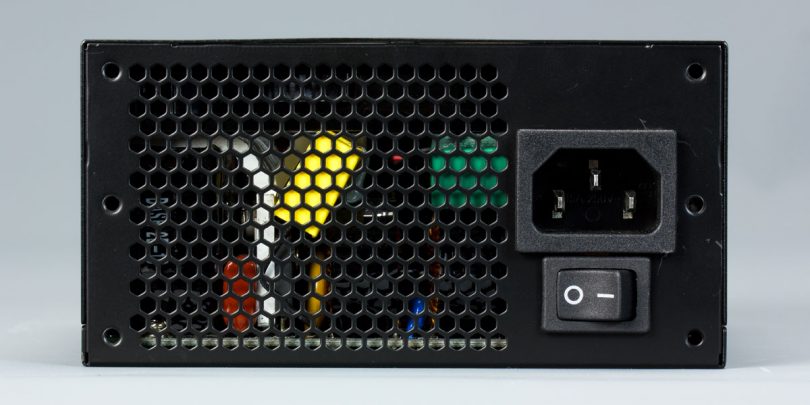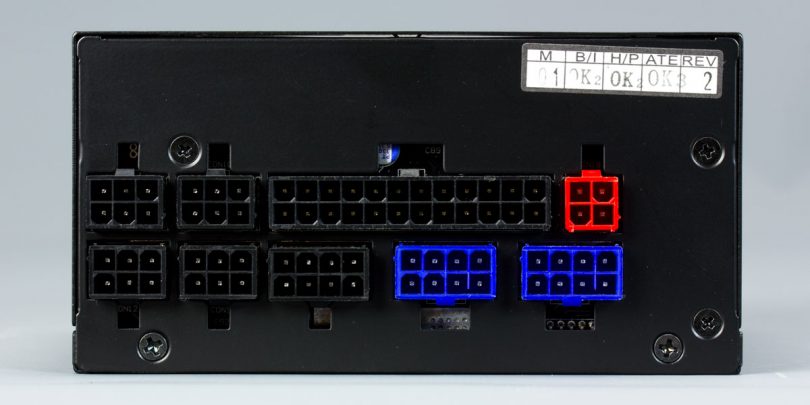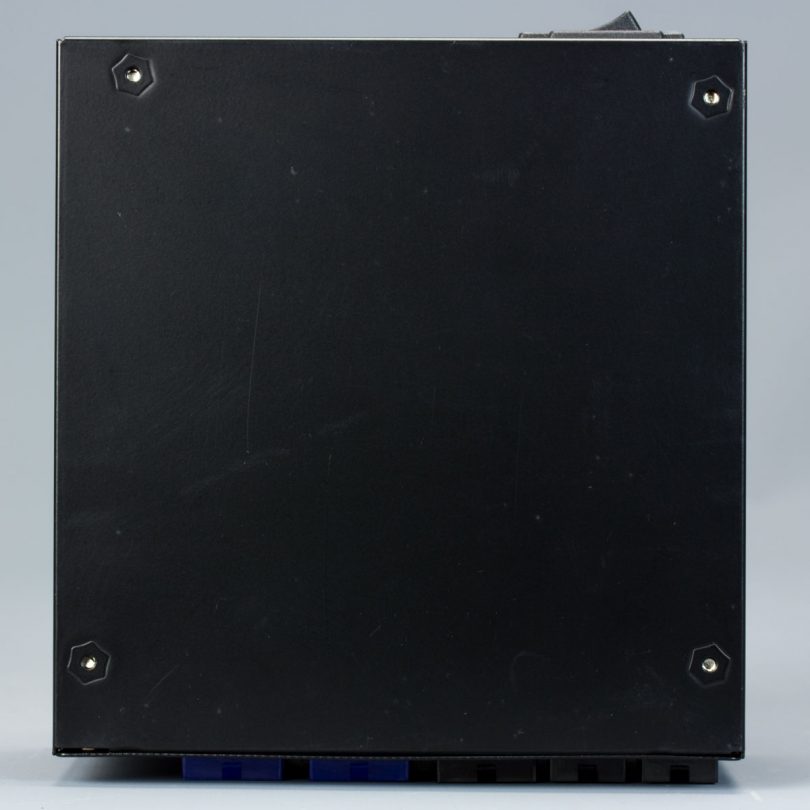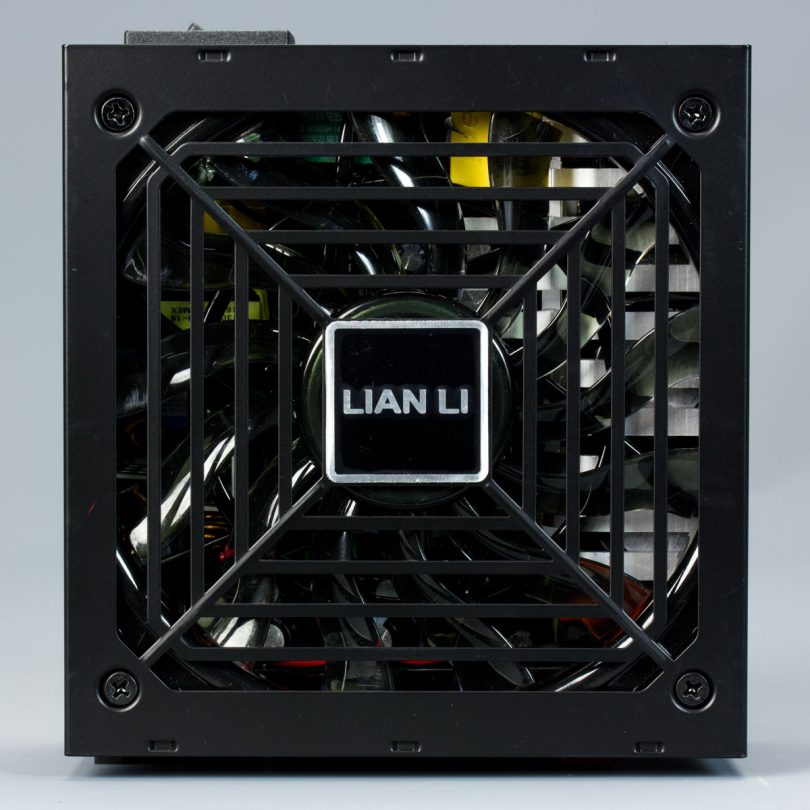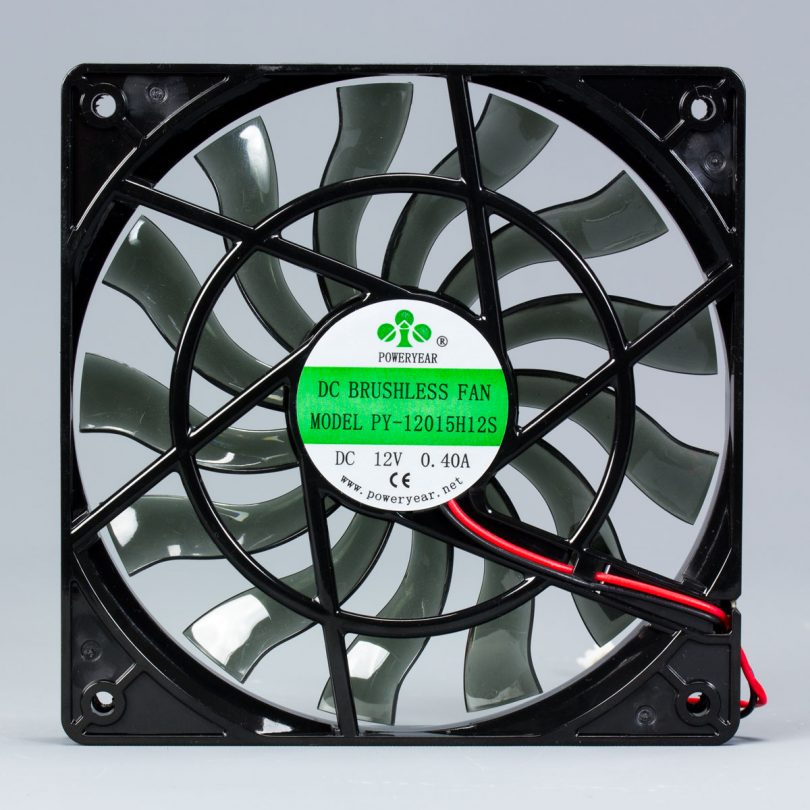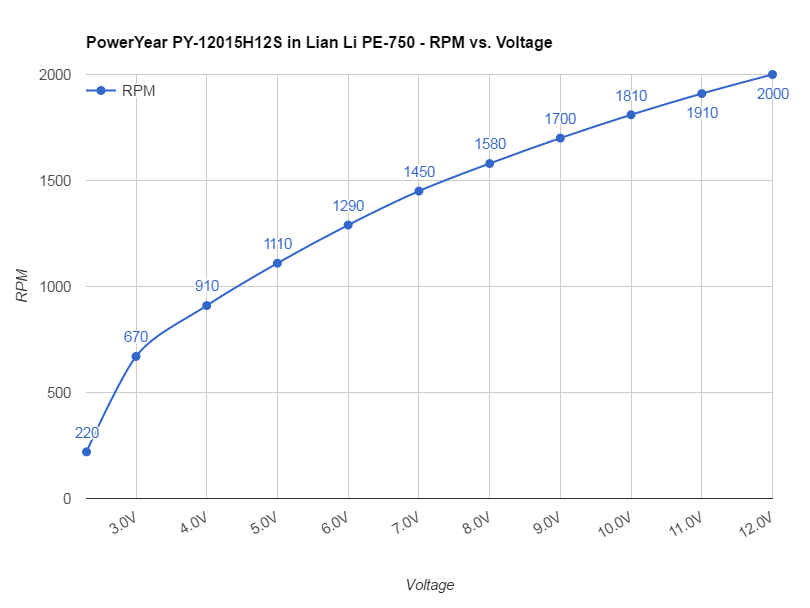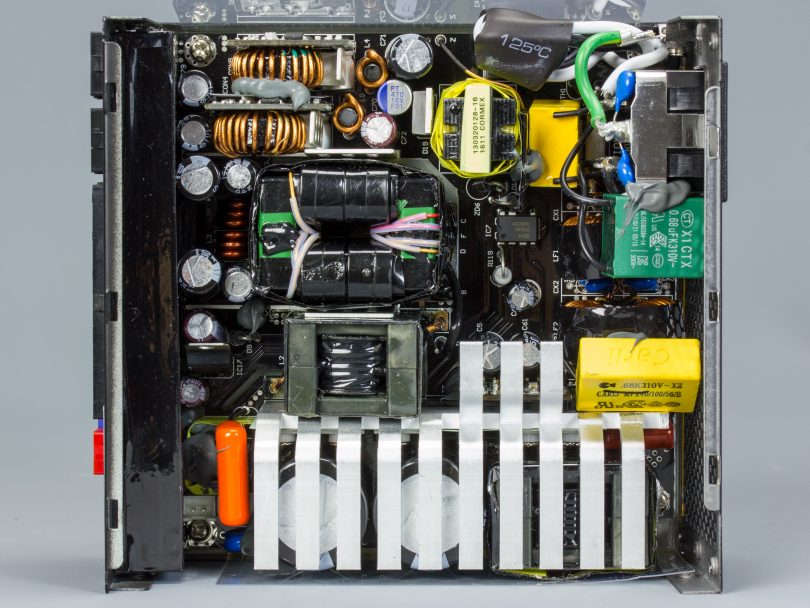Lian Li is renowned for their aluminum computer cases, but they’ve also offered power supplies at various times, either as standalone units or as PSU’s that were bundled with certain cases. However, it hasn’t been a product category they’ve really pushed in the last several years – so it was about as expected as the Spanish Inquisition for Lian Li to suddenly announce two high-wattage SFX-L power supplies, which is exactly what they did early last month.
The two new SFX-L units they first shared with the world in April were the PE-550 and the PE-750, and it’s the latter of which that is the subject of today’s review. The Lian Li PE-750 is a 750W Platinum-rated SFX-L power supply, complete with fully modular cables and, as expected for the larger SFX-L form factor, a slim 120mm fan.
Table of Contents
A disclaimer first before we get started: SFF Network does not currently possess the expertise or equipment to fully test the electrical performance of PC power supplies, and as such, this article should not serve as the sole data point in determining whether to purchase this product. We’ll be able to contextualize the utility and experience of using this unit with others in the market place, but we’d suggest having our own review supplement those by others who have the hardware and capability to do more thorough analysis of electrical performance, especially at higher wattages.
The Box
The front of the PE-750’s box is fairly simple. The brushed metal texture behind the picture of the unit is a neat touch, as a nod to Lian Li’s preferred finish for the computer cases they’re known for.
Coming around to the back of the box though is… uh… an exercise in minimalism?
The top of the box indicates which power cord is packed inside, and thus which market this SKU is intended for.
On the side of the box, we finally have some technical details about the contents. There’s the model number, load table, and safety/environmental certifications. As is becoming more and more common with enthusiast power supplies, the full rated power is available on just the 12V rail. This is great news for anyone who wants to run a high-end dual-GPU system off a SFF PSU, and needs every watt they can get.
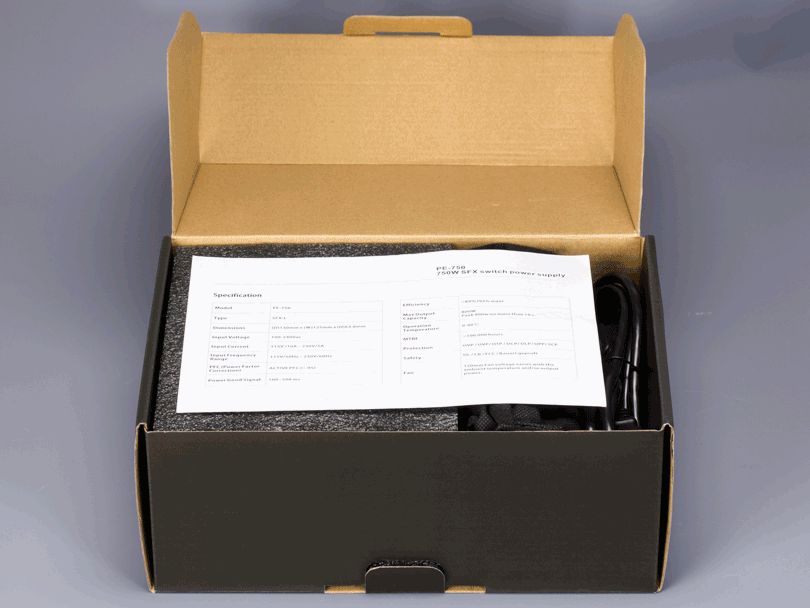
Inside the box is the “manual”, accessories, cables, and the PE-750 safely ensconced in some dense foam.
Accessories
Accessories include a piece of paper that seems to constitute the unit’s manual, power cord, and a black ATX to SFX adapter. Unlike the SilverStone SX700-LPT and the Corsair SF600, Lian Li decided to include an adapter. Which I’m glad they did, because several of their smaller cases (that have an ATX PSU located above the motherboard, especially) could benefit from using a SFX-L unit instead in order to gain more CPU heatsink clearance.
The bundled adapter is the same one that Corsair offers on their store, and that SilverStone has bundled with some of their SFX units. It’s not completely offset, so those wanting to maximize the space gained by using a SFX-L unit in a case intended for ATX will still want to look at the SilverStone PP08. But you can’t beat free.
The download links on Lian Li’s website for the PE-750 manual either goes to a Dropbox link that’s been disabled (due to excessive traffic), or a Google Drive link that gives a 404 error, so I’ve included pictures of the front and back of the manual that came with the unit. Hopefully they can fix those links or re-upload the manual relatively soon.
Edit: The download link for the manual has been corrected.
While this covers most of the basic information users would want, it stands in stark contrast to the documents typically provided by other manufacturers. One major omission is warranty information. In fact, I couldn’t find any info on the warranty for this unit anywhere other than the product listing on Newegg stating it comes with a 1-year warranty, and even then the warranty disclaimer came with no other details.
Edit: The Newegg listing and Lian Li’s website has been updated to show this unit comes with a 2-year warranty. Still no warranty details that I could find though.
Cables
What comes in the box isn’t quite as nice as the bag in the picture on their website, but Lian Li does include a basic cable storage pouch with the PE-750. We’ll take it over no pouch at all.
The PE-750 cables have the same flexible, ribbon-type wires as the newer SilverStone SFF units. The 24-pin, CPU, and PCIe cables are 18 AWG, however, compared to 16 AWG on the SilverStone (note that a larger AWG number translates into a thinner wire).
Cable lengths as follows from top to bottom:
- 3x 4-pin Molex + 1x Floppy (300mm / 200mm / 200mm / 100mm)
- 4x SATA (300mm / 200mm / 100mm / 100mm)
- 4x SATA (300mm / 200mm / 100mm / 100mm)
- 4x SATA (300mm / 200mm / 100mm / 100mm)
- 4+4-pin CPU (400mm)
- 24-pin motherboard (400mm)
- 2x 6+2-pin PCIe (400mm / 150mm)
- 2x 6+2-pin PCIe (400mm / 150mm)
(The first number is from the PSU-side to the first connector, and the second number is from the first connector to the second, and so forth.)
In case you think it’s a typo, this unit does indeed sport three strands of SATA cables with four plugs each, for a total of twelve. I’m really not sure what’s the point of including twelve SATA connectors on a SFX-L power supply… presumably this unit is intended to be used in SFF cases and yet 12 drives is more than many full tower cases can even support. But perhaps Lian Li sees an opportunity for using this sort of unit in a user-built NAS, or some such thing.
Looking to some of the other strands, we see that like the SX700-LPT, a floppy power connector is included. Unlike the SilverStone, though, it’s part of the Molex cable strand, and not a separate adapter. Floppy connectors are still used for fan controllers and the like, but those are less likely to be used in a SFF case due to space constraints, so I would have much rather seen that split off into an adapter instead of hardwired to the Molex cable.
Finally, the 24-pin cable has an additional 4-pin connector on the PSU side. Four of the wires on the motherboard-end of the cable are doubled up, and run into this extra connector. I assume it’s used for voltage sensing to improve the regulation, like the split connectors for the 24-pin cable on the Corsair SF600. For those wanting to custom sleeve the wires on this unit, it does turn on without that 4-pin connector plugged in, but I did not attempt running the unit like that at high load, so I cannot guarantee it’s stable in that configuration. Unless you have a particularly good reason, you should make sure to plug those wires in when in use.
Speaking of custom wiring, the pinout for the PE-750 looks mostly compatible with the SilverStone PSUs:
The peripheral, PCIe, and CPU cables look to be interchangeable. The 24-pin itself has the same pinout as well, but the addition of the extra 4-pin sense connector makes it questionable whether it’s safe to use a SilverStone 24-pin cable on the PE-750. Also, though it should not matter, the arrangement of the ground pins on the PCIe connector is different between the Lian Li and SilverStone.
All in all, I’m baffled by the decision to include 12 SATA connectors, but other than that, the length and types of the other connectors are suitable for a 700W SFX-L unit.
The Power Supply
After freeing it from the foam block, the PE-750 is wrapped in a simple plastic bag. Curiously, it does not come with any kind of sticker or label warning the user that the fan isn’t supposed to spin at low loads. Every other semi-fanless power supply I’ve seen comes with such a warning, so I’m curious if that will change in the future due to unaware users returning the unit thinking the fan is defective – especially since there’s nothing on the website that indicates that the PE-750 even has semi-passive functionality to begin with.
Let’s look at some of the other facets of this unit.
Coming to the side of the PSU, we find the typical sticker with the load table, warnings, and safety certifications. The warning just above the serial number sticker, is a bit strange though:
CAUTION! HAZARDOUS AREA
SELECT THE RIGHT VOLTAGE!
WITH FAN SENSOR CONTROL
“Hazardous area” and “With fan sensor control” are understandable, albeit worded poorly. “Select the right voltage” makes no sense, however, as this unit has active PFC, and as such there is not an input voltage selector switch. Perhaps we have some errant copy-pasta going on here.
Also, I find it funny that the “Warranty void if removed” warning is on this sticker, instead of having a secondary sticker covering one of the screws holding the housing together. One could completely disassemble and reassemble the entire power supply, and Lian Li would be none the wiser if it was sent in as defective – at least, not without taking the time to open the unit and do a thorough internal inspection first.
On the other side of the PSU, there is… nothing.
The PCB is inset at the corners, but if using non-standard screws, extra care should be taken when using the bottom two mounting holes as there isn’t any plastic shield to prevent a screw from coming into contact with the board.
Here we have the modular connectors. While I like to see a diagram to ensure there is no confusion, it’s pretty self-explanatory: the 6-pin connectors are for the SATA and Molex cables, the blue connectors are for PCIe, and the non-blue 8-pin then must be for the CPU.
The fan vent cutout on this unit is certainly distinctive. Eschewing a circular pattern, the PE-750 opts for a concentric square design. The ratio between vent and metal is good, so while I still would have preferred a wire grill, this actually works well as a way to both visually stand out from other power supplies on the market, and minimize airflow restriction.
Testing
As mentioned at the beginning of the review, we currently lack the expertise and equipment to properly evaluate the electrical performance of power supplies to a complete extent, so the following data is more to demonstrate that the Lian Li PE-750 is capable of powering the test system with no issues.
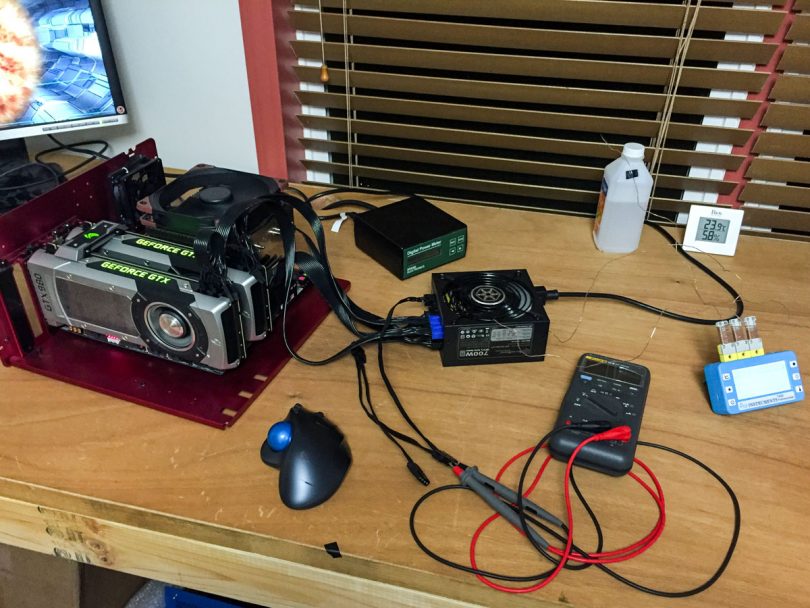
Test hardware:
| CPU | Intel Core i7-5930K |
| Motherboard | Asus X99-M WS |
| Cooling | Noctua NH-C14S with black NF-A14 PWM |
| PSU | Lian Li PE-750 |
| RAM | Crucial Ballistix Sport 16GB (4x8GB) DDR4 2400 |
| Video Card | 2x EVGA GTX 980 reference |
| Storage | Intel 750 400GB |
| Case | Lian Li PC-6X tray |
| OS | Windows 10 64-bit |
Test equipment:
- Brand Electronics 4-1850 power meter, used to measure the AC draw of the system.
- Reed AT-6 non-contact tachometer, used to measure the fan RPM (this is also the reason for the reflective sticker stuck to one of the fan blades in some of the pics).
- Pax Instruments T400 temperature datalogger, used to measure ambient, intake, and exhaust temps. Now with Omega thermocouples.
- Fluke 83 III multimeter to measure voltage.
Methodology:
Each test is run for 10 minutes, and then readings are taken before moving on to the next test. Both video cards were installed for all tests, but on the fourth test SLI was disabled and FurMark was run on a single GPU. For the last test, SLI was enabled and FurMark was run on both.
Test Results:
| Wattage (AC) | Ambient Temp | Intake Temp (delta) | Exhaust Temp (delta) | Fan RPM | 12V | Test |
| 60W | 21.9°C | 29.1°C (7.2°C) | 25.6°C (3.7°C) | 0 | 11.92V | Idle |
| 110W | 21.9°C | 32.2°C (10.3°C) | 26.0°C (4.1°C) | 0 | 11.93V | 2 threads of Prime95 Blend |
| 180W | 22.4°C | 22.5°C (0.1°C) | 27.3°C (4.9°C) | 850 RPM* | 11.93V | 10 threads Prime95 Blend |
| 340W | 23.0°C | 23.2°C (0.2°C) | 30.1°C (7.1°C) | 850 RPM | 11.96V | 10 threads Prime95 Blend, FurMark 1x 980 720p no AA |
| 500W | 24.6°C | 24.6°C (0.0°C) | 34.6°C (10°C) | 860 RPM | 11.99V | 10 threads Prime95 Blend, FurMark 2x 980 4K 4x AA |
*Fan spun up immediately after starting the test
As I would expect for a 750W PSU, I had no problems powering a 5930K CPU and dual GTX 980s at full load.
Fan
The fan looks identical to the one used in the SilverStone SFX-L units. A nice improvement over those units, though, is the use of little rubber washers in the corners to reduce vibration transfer between the fan and the PSU housing. It’s a small thing, but anything that potentially reduces the noise profile of the PSU is a good thing in my eyes.
Annoyingly, this fan has the exact same model number (PY-12015H12S) as the fan in the SX700-LPT, even though it’s not the same. The SilverStone version is 0.22A, while the Lian Li version is 0.40A.
The resulting voltage/RPM curve is as follows:
The PE-750 version of the fan starts at a lower voltage and RPM compared to the SX700-LPT, at 2.3V and 220 RPM compared to 2.6V and 490 RPM for the SilverStone. At every voltage point past that it’s at a slightly higher RPM, ending up at 2000 RPM. The fan cleanly starts and stops at 2.6V, with no spurious chirps or squealing around the starting voltage.
Fan Controller
The PE-750 appears to be using a primarily load-based fan controller with secondary temperature input, just like the SX700-LPT. However, the end behavior is quite different. At 60W load (measured from the wall) the output voltage from the 2-pin internal fan header is 0.03V and at 105W it is still at 0.03V. In test 3, at 190W, the voltage immediately jumps to 3.63V with the fan at 850 RPM.
From here, things get a bit odd. At 340W, we find that the voltage has only increased to 3.64V – and at 500W, it’s just a bit higher yet at 3.66V, yielding a 860 RPM fan speed. This is quite different than most semi-fanless power supplies, which typically turn the fan on at a low RPM and increase the fan speed as load and/or temperature increases depending on the controller design. Here, we have a curve that’s quite noticeably… flat.
Indeed, at least with an ambient temperature of 22-23°C, the PE-750 exhibits more of a fan “line” than a fan curve. The unit does take temperature into the equation, though, as when I used a heatgun to increase the intake air temperature with the unit under load, the fan RPM did increase in response. So this is by no means unintended behavior – this is merely just how the unit has decided to behave.
In any case, after closing the load test software, the fan continued spinning for 5 seconds and then the voltage dropped to 0.4V and the fan shut off. I’ve checked this a few times since the initial testing and the fan consistently shuts off after the load drops back down.
Noise
For noise, I’ll mostly be comparing the Lian Li PE-750 against the SilverStone SX700-LPT since they’re close competitors. The fan blades are the same, so at similar fan RPMs, the two units have similar levels of noise. One minor difference is that the fan in my particular SX700-LPT has more bearing noise compared to my PE-750. Since the fans aren’t actually identical (given the different voltage/RPM curve), I’m not sure if that’s because the SilverStone version of the fan is more suspectible to bearing noise, or if it can just be chalked up to manufacturing variation. Without multiple samples of each model it’s impossible to say.
Both units have load-based controllers that allow them to more reliably keep the fan off at low loads compared to the strictly temperature based systems of other SFX and SFX-L units on the market. The difference in how the controller responds to different load levels, however, leads to markedly different fan speed profiles, and thus noise levels. At least in the open-air testing I conducted, the fan in the SX700-LPT stays off longer, and when it does start, it’s at a lower RPM compared to the PE-750. In terms of numbers, the SX700-LPT fan stayed on starting at test 3 at 350W and 620 RPM, while the PE-750’s fan started in test 2 at 180W and 850 RPM.
Things turn around at the 500W load (that is the maximum I can draw with my system), though, since the PE-750 barely increases in speed, while the SilverStone fan ends up at quite a bit higher RPM at that load, 860 RPM versus 1180 RPM respectively.
So there is no clear answer on which unit is superior as far as noise level is concerned, and it will ultimately come done to your priorities. For example, for me, heavy loads usually means gaming, so I’d have headphones on and I’m less concerned about noise as long as it’s not audible over the video cards. But I highly value low/no noise at low loads when I’m surfing the internet or watching a movie, so in that regard the SX700-LPT seems like a better choice. At 850 RPM, the Lian Li is audible, but it’s not real loud, so someone who isn’t as picky at idle but wants overall less noise across the load range would be better served by the PE-750.
Internals
I’m no PSU expert so I won’t speak to the internal build quality, but all the electrolytic capacitors I could see are either Nippon Chemi-con or Rubycon, and from what I could see they were all at least 105°C rated, with a few that are 125°C rated. Nippon Chemi-con and Rubycon caps are Japanese, and are generally considered to be first-tier. That’s on par with SilverStone’s capacitors, and a particularly good thing to have in such a powerful (and consequently warm) unit.
Enhance Electronics is the OEM for the PE-750, and this is the same company behind the SilverStone SX600-G. Since the SX700-LPT is OEMed by High Power, this means we have not just two products, but two different high-wattage, high-efficiency SFX-L platforms! This is great news for SFF enthusiasts, because more competition will hopefully spur an arms race towards even better SFX-L power supplies. Maybe one day we’ll see the form factor displace ATX for the majority of PC builders, as that simply can’t come soon enough.
Conclusion
Overall, I have mixed feelings about the Lian Li PE-750. The unit itself seems more than up to the task of powering high-end SFF systems, and it comes with flexible, modular cables which I love to see. Furthermore, having Lian Li as a new entrant to the market is an exciting prospect, and an endeavor we should all hope they can follow-through on and execute well.
However, perhaps some of this ‘newness’ (for lack of a better word) is showing on their part, as we have a pretty sparse manual and no warranty information that I could find for this unit anywhere other than Newegg, which only indicated a 1-year warranty on their product listing. A forum member had emailed Lian Li and apparently one of their reps is saying it comes with a 2-year warranty but I need to confirm that. Either way, I think only having a one or two year warranty on what is the most expensive SFX or SFX-L PSU on the market (at $160) is something that could stand to be improved, especially considering the Corsair SF600 comes with a 7-year warranty and that unit is $40 cheaper.
Edit: The Newegg listing and the Lian Li website now both show a 2-year warranty for this unit.
Noise is an interesting aspect of this unit. I was completely surprised to find the PE-750 is actually semi-fanless, since it isn’t mentioned anywhere on the website or marketing material. The semi-fanless functionality works reliably at keeping the fan off at low loads too, though once it does start it is at a minimum speed of 850 RPM. The fan profile is pretty relaxed however, only increasing to 860 RPM at 500W load as measured from the wall. This does result in lower noise at the same load compared to the SilverStone SX700-LPT but I worry this could result in more stress on the components due to less cooling. I’m not a PSU engineer though so that’s just speculation on my part.
Edit: At Computex 2016, SilverStone showed off a 800W Titanium-rated unit based on the same platform. If the platform is capable of even higher wattage and efficiency, that may explain the relaxed fan profile when operating in open-air.
In the end, whether to choose the PE-750 or the SX700-LPT will come done to priorities, there is no clear-cut winner, they’re both equally capable products. I will say though, it’s amazing to think that just two years ago the SilverStone SX600-G was the only option for dual-GPU SFF builds and now we have not one, but two 700W+ Platinum-rated SFX-L power supplies!
The PE-750 is currently available from Newegg for $160.
Thoughts? Discuss them in the forum here.

